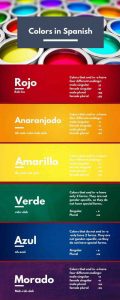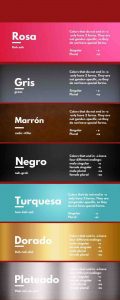In order to learn Spanish colors, it is important to first understand the basics of the language.
Here, we provide a comprehensive guide to help you get started. We also include an infographic that outlines the colors in Spanish and their corresponding translations.
With this information, you’ll be able to start identifying and using colors in Spanish with ease!
What are the 11 Colors in Spanish?
Spanish is a very expressive language, with a wide range of colors that can be used to describe emotions and experiences. The 11 colors in Spanish are:
- Negro
- Blanco
- Rojo
- Amarillo
- Azul
- Verde
- Naranja
- Violeta
- Gris
- Marron
- Celeste
Each of these colors has its own unique meaning and can be used to create beautiful works of art. When used skillfully, the colors in Spanish can add depth and feeling to any message.
Ready to learn everything you need to know about Spanish colors – and the language in general? Sign up for Spanish lessons! You’ll learn the entire rainbow, plus more fun Spanish vocabulary like what you see in the video below:
https://www.youtube.com/watch?v=arZ9PCqmCa4
Spanish Colors List
Spanish colors are some of the easiest to learn, because so many of them are cognates—words that look similar to their English counterparts. For example, “blanco” looks a lot like “blank,” and “rojo” looks like “red.” Here is a list of Spanish colors, along with their English translations:
- Blanco: white
- Rojo: red
- Azul: blue
- Amarillo: yellow
- Verde: green
- Naranja: orange
- Rosa: pink
- Morado: purple
- Marron: brown
- Negro: black
Apart from these basic colors, you might also hear the following terms:
- Gris: gray
- Café: coffee color, or brown
- Claro: light
- Oscuro: dark
You can also describe colors using adjectives such as “brillante” (bright) or “sutil” (subtle). When describing someone’s skin color or hair, you can use adjectives such as “moreno” (tan) or “rubio” (blond). With a little practice, you’ll be able to describe any color in Spanish!
Why Do You Need to Know All Colors in Spanish?
Knowing your colors in Spanish can be quite useful, especially if you are shopping. But as you expand your vocabulary it is also important to know the grammar on how to use your new terms. It may come as a surprise to you that colors can have a gender. Now, don’t you run just yet. We are going to break this down, and by the end of this blog you will be able to describe things by their color. Let’s start with some basic colors.
Using Colors as Adjectives
Colors are adjectives, and adjectives help us to describe objects, animals, people, places, etc. They are descriptive in nature. In the beginning, when we start learning Spanish colors we learn that nouns and adjectives must agree in gender and number. Meaning that the adjective has to match the gender and the quantity of the noun. As you keep on reading you learn the patterns and rules on how to use these colorful words properly! Let’s check out the colors.
Now that we have some colorful vocabulary to use you are probably wondering, So how and when do we use the colors? Well, let’s use the color list I gave you at the beginning of the post. You will notice that there are four possible endings for color in their infinitive form: -o, -a, -e or a consonant. This means we can separate them into two groups of colors, one for colors ending in -o and one for the rest of the other endings.
Colors Ending in -o
When learning the colors you have questions such as: What are colors in Spanish? And do colors have gender in Spanish? The group of colors ending in -o includes all the colors that behave like normal adjectives.
There are 2 rules that we have to remember:
- These will have to follow the noun they modify (all descriptive colors do this).
- They have four forms: masculine singular, feminine singular, masculine plural, and feminine plural.
The form you use depends on the gender and number of the noun being modified.
Colors that end in -o have four different endings:
| male singular | female singular | male plural | female plural |
| -o | -a | -os | -as |
Let’s use the color rojo (red) as an example and make sentences:
El lápiz rojo (m. sg.). (The red pencil.)
La pluma roja (f. sg.). (The red pen.)
Los lápices rojos (m. pl.). (The red pencils)
Las plumas rojas (f. pl.). (The red pens.)
Once you memorize the color, the only thing you have to remember is to change its ending so that it agrees with the noun.
Colors Ending in -a, -e or a Consonant
For the color endings that do not end in – o things get easier! You see, these endings only have two forms, one for the singular and one for the plural. That is it. They are not gender-specific, so they do not have a special feminine or masculine form. So fewer things to remember!
Here is a list of stationery supplies that you will find in your office or classroom
La pluma rosa (The pink pen)
El lapiz rosa. (The pink pencil)
Los cuadernos rosas. (The pink notebooks.)
Las plumas rosas (The pink pens.)
In the examples above, the word rosa is modifying four different nouns, but only changes if the noun is plural. See how simple it is?
The same is true for all other colors in this group. Here are some more examples:
El cuaderno verde. (The green notebook.)
La engrapadora verde. (The green stapler.)
Los cuadernos azules. (The blue notebooks.)
Las engrapadorass azules. (The blue staplers.)
Here are Some Questions & Responses You Can Use as Practice!
¿Cuál es tu color favorito? (What’s your favorite color?)
Mi color favorito es + color. (My favorite color is …)
¿De qué color es tu…? (What color is your…?)
El color es… (The color is…)
Whew, that was a lot. Am I right? But you did it! You now have an idea of how to use colors. This was a lot of information, but you do not need to learn it all at once. Take your time and study one section before starting the next one. You will be so happy when you realize you not only know how to name the colors in Spanish, but also can have a conversation about what are the Spanish colors and use them properly!
How to Practice Spanish Colors
Learning colors in Spanish is a great way to quickly increase your vocabulary. It can also be a lot of fun. Here are a few tips to help you get started.
First, find a picture that includes a lot of different colors. A good option is a photograph of a flower garden or a fruit bowl. Spend a few minutes looking at the picture and identifying as many colors as you can in Spanish.
Once you have identified all of the colors you can, it’s time to put your knowledge to the test. Find objects around your house that match the colors in the picture and label them with the corresponding Spanish word.
Don’t worry if you don’t have an object for every color – just label as many as you can.
Finally, practice saying the words out loud. The more you repeat them, the easier they will become to remember. With a little practice, you’ll be speaking like a native in no time!
Colors in Spanish – You’ve Got This!
So there you have it, the colors of the Spanish language. Now that you know all about them, what are you waiting for? Sign up for some Spanish lessons and start speaking Spanish like a pro! And if you need a little help getting started, be sure to check out our comprehensive guide to Spanish grammar. Hasta pronto!
Rosita Ruiz


